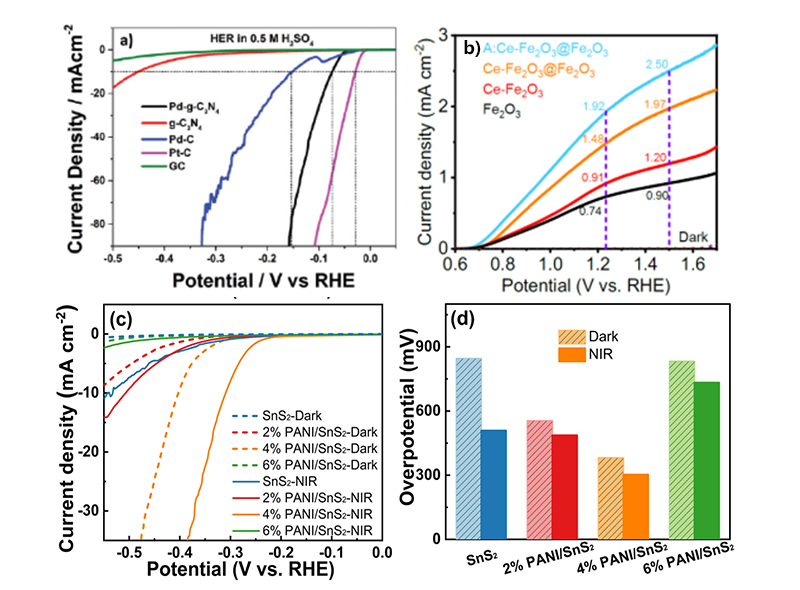Original content is precious. If you wish to republish this article, please contact our staff and include the source information in the republished article, otherwise copyright infringement procedures will apply!
Overpotential, also known as overvoltage or superpotential, refers to the part where the actual voltage required exceeds the theoretical voltage during the process of electrocatalysis or photocatalysis when a certain current density is reached.
In an ideal scenario, the operational potential required for electrocatalysis or photocatalysis is the same as the potential at equilibrium. However, in practical reactions, the working potential often needs to overcome the barriers of kinetic processes, resulting in a numerical value higher than the equilibrium potential. The voltage exceeding the theoretical value is called overpotential, mainly used to overcome activation resistance and charge transfer resistance, among other resistances[1].
Simplistically, overpotential refers to the difference between the actual potential and the equilibrium potential when the current density reaches a specified level. It directly reflects the catalytic activity of electrocatalytic or photocatalytic reactions.
According to the Nernst equation[2], the actual working potential E can be represented as:

E: Actual working potential of the reaction
E0: Standard potential of the reaction
T: Absolute zero (273.15°C)
R: Ideal gas constant
F: Faraday's constant (96485 C/mol)
N: Number of electrons transferred in the reaction
C0: Concentration of the oxidized product
CR: Concentration of the reduced product
The basic formula for overpotential is:

 : Overpotential
: Overpotential
 : Actual potential
: Actual potential
 : Theoretical potential
: Theoretical potential
In theory, as overpotential  approaches 0 V, the better the performance of the catalyst. A lower actual voltage is required to achieve the relative current density, resulting in lower energy consumption and higher catalytic activity[3].
approaches 0 V, the better the performance of the catalyst. A lower actual voltage is required to achieve the relative current density, resulting in lower energy consumption and higher catalytic activity[3].
It's important to note that when comparing the overpotentials of different catalysts, the specific current density must be specified; otherwise, the results of the comparison will not have much significance.
Typically, at a current density of 10 mA/cm-2, lower overpotential indicates a stronger catalytic ability for the target reaction, making it a common condition for assessing catalyst performance.

Fig.1 (a) and (c) Polarization curves[4, 5]; (b) LSV curves[6]; (d) Overpotentials (at 10 mA·cm-2) [5].
[1] Zhu Han, Wang Qingfa*, Gao Guohua*, et al. When Cubic Cobalt Sulfide Meets Layered Molybdenum Disulfide: A Core-Shell System toward Synergetic Electrocatalytic Water Splitting[J]. Advvanced Materials, 2015, 27(32): 4752.
[2] Bard Allen J, Faulkner Larry R, Leddy Johna, Zoski Cynthia G. Electrochemical Methods: Fundamentals and Applications[B], Department of Chemistry and Biochemistry University of Texas at Austin, Wiley, vol. 12. New York, 2000.
[3] S. Anantharaj, S. R. Ede, Subrata Kundu*, et al. Precision and correctness in the evaluation of electrocatalytic water splitting: revisiting activity parameters with a critical assessment[J]. Energy & Environmental Science, 2018, 11:744.
[4] Priti Sharma, Debdyuti Mukherjee, Yoel Sasson*, et al. Pd doped carbon nitride (Pd-g-C3N4): an efficient photocatalyst for hydrogenation via an Al-H2O system and an electrocatalyst towards overall water splitting[J]. Green Chemistry, 2022, DOI: 10.1039/d2gc00801g.
[5] Zhang Ya, Hu Lang, Zhang Yongcai*, et al. NIR Photothermal-Enhanced Electrocatalytic and Photoelectrocatalytic Hydrogen Evolution by Polyaniline/SnS2 Nanocomposites[J]. ACS Applied Nano Materials, 2022, 5, 391.
[6] Bai Jinwei, Hjinlu*, Wang Lei*, et al. Reduction of Charge Carrier Recombination by Ce Gradient Doping and Surface Polarization for Solar Water Splitting[J]. Chemical Engineering Journal, 2022, 448: 137602.